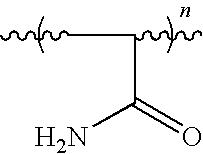Formulation for dust abatement and prevention of erosion
- Summary
- Abstract
- Description
- Claims
- Application Information
AI Technical Summary
Benefits of technology
Problems solved by technology
Method used
Image
Examples
example 1
[0029]On one area, a dilute formulation was applied. The dilute formulation consisted of 1,200 pounds granulated sugar, 250 milliliter dishwashing liquid, 1 pound phosphate salt, 150 pound starch and 1200 gallons of water.
example 2
[0030]In the second area, the formulation consisted of a more concentrated formulation. The more concentrated formulation consisted of 1,200 pounds granulated sugar, 250 milliliters dishwashing liquid, 1 pound phosphate salt, 150 pound starch and 400 gallons of water.
[0031]In both examples, the results were excellent. Within minutes of application and evaporation of the water, a solid hardened crust formed. The following day, helicopters landed on both of the test sites multiple times with almost complete reduction of airborne sand and dust. Even the areas of the surface that were damaged by the landing gear and / or landing wheels automatically self-healed to regenerate a top hardened surface. Various military helicopters performed landings, touch-and-goes, and hovering maneuvers the following day with equal success.
[0032]Examples 3 and 4 below describe additional field testing that was done using corn syrup as the sugar. Again, the results were excellent with a solid hardened crust ...
example 3
[0033]The solution consisted of 130 gallons of corn syrup, 4 pounds phosphate salt, 2.5 gallons liquid starch, 300 mL of liquid soap and 865 gallons of water.
PUM
 Login to View More
Login to View More Abstract
Description
Claims
Application Information
 Login to View More
Login to View More - R&D
- Intellectual Property
- Life Sciences
- Materials
- Tech Scout
- Unparalleled Data Quality
- Higher Quality Content
- 60% Fewer Hallucinations
Browse by: Latest US Patents, China's latest patents, Technical Efficacy Thesaurus, Application Domain, Technology Topic, Popular Technical Reports.
© 2025 PatSnap. All rights reserved.Legal|Privacy policy|Modern Slavery Act Transparency Statement|Sitemap|About US| Contact US: help@patsnap.com

